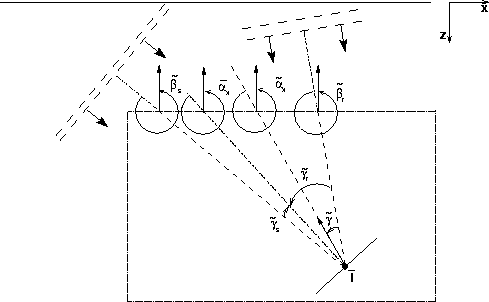In anisotropic media, when the reflector is dipping with
respect to the normal to the isotropic axis of symmetry
(horizontal direction for VTI) the incident and reflected
aperture angles differ.
This difference is caused by the fact that,
although the phase slowness is function of the propagation angle,
Snell law requires that the
components parallel to the reflector
of the incident and reflected slowness vectors
must match at the interface.
However, we can still define an ``average'' aperture angle ![]() and ``average'' dip angle
and ``average'' dip angle ![]() using the following relationships:
using the following relationships:
| |
(8) |
 |
Figure ![[*]](http://sepwww.stanford.edu/latex2html/cross_ref_motif.gif) shows the geometric
interpretation of these angles.
Notice that the average dip angle
shows the geometric
interpretation of these angles.
Notice that the average dip angle
![]() is different from the
true geological dip angle
is different from the
true geological dip angle ![]() ,and that the average aperture angle
,and that the average aperture angle ![]() is
obviously different from the true
aperture angles
is
obviously different from the true
aperture angles ![]() and
and ![]() .However, these five angles are related
and, if needed, the true angles can be derived
from the average angles,
as shown in Appendix A.
.However, these five angles are related
and, if needed, the true angles can be derived
from the average angles,
as shown in Appendix A.
Prestack images defined in the subsurface-offset ![]() domain
are transformed into the angle domain by applying slant stacks.
The transformation axis is thus the physical dip
of the image along the subsurface offset;
that is,
domain
are transformed into the angle domain by applying slant stacks.
The transformation axis is thus the physical dip
of the image along the subsurface offset;
that is,
![]() .The dip angles can be similarly related to the midpoint dips
in the image;
that is,
.The dip angles can be similarly related to the midpoint dips
in the image;
that is,
![]() .Following
the derivation of acoustic isotropic ADCIGs
by Sava and Fomel (2003)
and of converted-waves ADCIGs by
Rosales and Rickett (2001),
we can write the following relationships between
the propagation angles and the derivative
measured from the wavefield:
.Following
the derivation of acoustic isotropic ADCIGs
by Sava and Fomel (2003)
and of converted-waves ADCIGs by
Rosales and Rickett (2001),
we can write the following relationships between
the propagation angles and the derivative
measured from the wavefield:
 |
(9) | |
| (10) | ||
| (11) |
 |
(12) | |
| (13) |
Solving for ![]() and
and ![]() we obtain the following:
we obtain the following:
 |
(14) | |
| (15) |
Substituting equation 15 in equation 14, and equation 14 into equation 15, we get the following two quadratic expressions that can be solved to estimate the angles as a function of the dips measured from the image:
 |
(16) | |
| (17) |
For anisotropic velocities, the slownesses depend on the propagation
angles, and thus the normalized difference depends on
the unknown ![]() and
and ![]() .In practice, these equations can be solved by
a simple iterative process that starts by
assuming the ``normalized difference'' to be equal to zero.
In all numerical test I conducted
this iterative process converges to the correct solution in
only a few iterations, and thus is not computationally demanding.
.In practice, these equations can be solved by
a simple iterative process that starts by
assuming the ``normalized difference'' to be equal to zero.
In all numerical test I conducted
this iterative process converges to the correct solution in
only a few iterations, and thus is not computationally demanding.
If the anisotropic slowness function were spatially homogeneous,
equations 16 and 17
could be solved iteratively in the Fourier domain,
and the transformation to the average angles ![]() and
and ![]() could be computed exactly without the need of estimating
the apparent reflector dip in the space domain.
When the anisotropic parameters are a function of the spatial variables;
that is, in the majority of the real situations,
the solution of equations 16 and 17
requires the estimation of the local reflector dip in the space domain.
If necessary,
the reflectors' dip can be either extracted from
the interpretation of the horizons of interest,
or can be automatically estimated from the image
by applying one of the several methods
that have been presented in the literature
(see for example Fomel (2002)).
In practice,
the estimation of the reflector dip is seldom necessary.
The numerical and real-data examples shown below indicate
that for practical values of the anisotropy parameters
the dependency of the estimate from the dip angles
can be safely ignored for small dips,
and it is unlikely to constitute a problem for steep dips.
could be computed exactly without the need of estimating
the apparent reflector dip in the space domain.
When the anisotropic parameters are a function of the spatial variables;
that is, in the majority of the real situations,
the solution of equations 16 and 17
requires the estimation of the local reflector dip in the space domain.
If necessary,
the reflectors' dip can be either extracted from
the interpretation of the horizons of interest,
or can be automatically estimated from the image
by applying one of the several methods
that have been presented in the literature
(see for example Fomel (2002)).
In practice,
the estimation of the reflector dip is seldom necessary.
The numerical and real-data examples shown below indicate
that for practical values of the anisotropy parameters
the dependency of the estimate from the dip angles
can be safely ignored for small dips,
and it is unlikely to constitute a problem for steep dips.